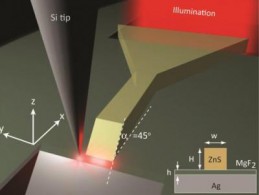Nanoscale waveguide for future photonics
June 1, 2011

The hybrid plasmon polariton (HPP) nanoscale waveguide consists of a semiconductor strip separated from a metallic surface by a low dielectric gap (credit: Xiang Zhang group)
The first true nanoscale waveguides for next generation on-chip optical communication systems have been demonstrated by researchers at Lawrence Berkeley National Laboratory (Berkeley Lab).
The researchers used a hybrid plasmon polariton (HPP), a quasi-particle they conceptualized and created, in a nanoscale waveguide system that is capable of shepherding light waves along a metal-dielectric nanostructure interface over sufficient distances for the routing of optical communication signals in photonic devices.
The key was the insertion of a thin low-dielectric layer between the metal and a semiconductor strip, the researchers said.
They were able to reveal mode sizes down to 50-by-60 square nanometers using Near-field Scanning Optical Microscopy (NSOM) at optical wavelengths.
“The HPP mode is advantageous for down-scaling physical device sizes, and also for delivering novel physical effects at the device level that pave the way for nanolasers, quantum photonics, and single-photon all-optical switches,” says Ziliang Ye.
The researchers envision applications such as all-optical transistors, electro-optical modulators, and bio-molecular sensors.
Ref.: Volker J. Sorger, Ziliang Ye, et al., Experimental demonstration of low-loss optical waveguiding at deep sub-wavelength scales, Nature Communications, 2011; 2: 331 [DOI:10.1038/ncomms1315]